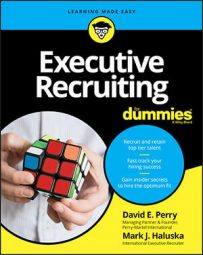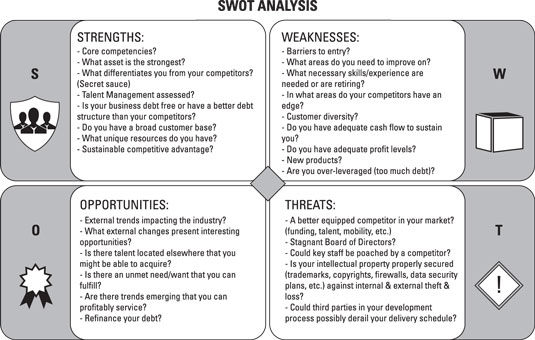In the context of executive recruitment, competitors might mean direct competitors, indirect competitors, suppliers, and so on. After all, every organization competes for talent at the executive level!
- Strengths: Strengths are the things that make an organization better than its competitors. Examples of strengths include popular products or services, an established customer base, a golden reputation in the marketplace, strong management, qualified employees, ownership of patents and trademarks, or anything else that sets the company apart from the competition.
Strengths should always be gauged against those of a competitor. Something you do just to keep up with the competition is not a strength. It's a necessity.
- Weaknesses: These are the areas in which a company does not perform well, making it vulnerable to aggressive competitors or negative market forces. Weaknesses might include poor management, employee problems, high turnover, lack of marketing and sales expertise, lack of capital, bad location, poor products or services, a damaged reputation, and so on. These conditions make it more difficult to attract the right candidates, so it's imperative to identify them now.
- Opportunities: Opportunities are things that could make your business stronger, more enduring, or more profitable — for example, the emergence of new markets or the expansion of old ones; possible mergers, acquisitions, or strategic alliances; a competitor going out of business or leaving the marketplace; or the availability of a desired employee.
- Threats: Threats are the things that could adversely affect a business. Threats might include changing marketplace conditions, rising company debt, cash-flow problems, the entrance of a strong competitor in the market, competitors with lower prices, possible laws or taxes that may negatively affect the company's profits, or strategic partners going out of business.
Ultimately, the purpose of a SWOT analysis is to help companies build on their strengths, minimize or correct their weaknesses, leverage opportunities, and formulate a plan to deal with potential threats.
Performing a SWOT analysis is no small task. Usually, it's done in conjunction with the search chair and maybe the search committee. (If the role you're filling is of the super-senior variety, you might want to do it with the board instead.) The good news? There's a chance that other departments will have already done a lot of the heavy lifting for you. Marketing and sales often conduct SWOT analyses to ensure they understand how the company is perceived in the market. And odds are, the finance group has a business analyst on staff who can help you out, too.How do you perform a SWOT analysis? To start, grab a piece of paper and draw one vertical line and one horizontal line on it to divide it into four quadrants or squares. In the top-left square, write Strengths. In the top-right square, right Weaknesses. In the bottom-left square, write Opportunities. Finally, write Threats in the remaining square.
Next, detail the company's strengths, weaknesses, opportunities, and threats in the appropriate squares. There will be obvious ones, of course — like, "The company is the market leader for product x." But you'll also want to try to uncover SWOTs that are a bit less apparent.
To assess the organization's weaknesses, it helps to do a little sniffing around to find out what its employees say about it. Good places to start include Glassdoor, PayScale, Vault, The Muse, Comparably, and Blind. You can also try Google and the Better Business Bureau if the organization is large enough.
Finally, here are some general questions to spark discussion:- What about each of the company's main competitors stands out?
- What does the organization offer that its competitors do not?
- What doesn't the organization offer that its competitors do?
- What is the company's rank or position in the industry? What about its competitors?
- How long has the organization been in operation? What about its competitors?
- How is compensation — salary, bonuses, options, equity — determined at the company and at its competitors?
- Are the organization's benefits better than, comparable to, or worse than those offered by its competitors?
- Are the organization's advancement opportunities better than, comparable to, or worse than its competitors?
- What is the organization's forecasted growth? What about its competitors?
- Is the company in expansion mode? What about its competitors?
- How is the company's core operation trending? What about its competitors?
- How valuable is the company's credibility? What about its competitors?
- What was the company's revenue percentage increase or decrease for the previous year? What about its competitors?
Prospective candidates will also want to know which departments in the company are strong and which are weak.


